Every few minutes, I wiggle toes inside boots and slap hands against thighs.
It’s cold — the kind of cold that makes hard work out of passivity. I’ve been standing outside for an hour reading signs, and I’m frozen to the marrow.
January in Ukraine is serious business, the grey skies flattening landscape and mood, the sidewalks icy and treacherous. Before stepping out the door of my well-appointed hotel room, I’d had a bracing talk with the chandelier hanging over the queen-sized bed, looking to the ornate crystals for assurance that fleece tights under my pants would protect against the wind; that it was okay to step over the snoring homeless man who had set up a cardboard pallet on the landing between my room and reception; that my new map app would guide me to my goal; that the hungover smokers, empty beer bottles, and rotting garbage in the courtyard were welcome set decoration for a travel tale entitled “New Year’s Day in Kiev.”
Emotionally fortified, I had added a pair of socks over the tights, wrapped a scarf from chest to lips, snapped my new wool coat over a thick sweater, and crammed my beloved fur hat – the only thing to keep me warm in the steppelands of Eastern Europe – onto my head. The walk to Independence Square would only take twenty minutes, but since January 1st is a major holiday in former Soviet countries, I presumed businesses would be closed and planned to spend the entire day outside, exploring the parts of the city without walls.
An hour later, as I stand reading signs and tucking my hands into my armpits, I realize I was wrong: even on New Year’s Day, Kiev thrums. Certainly, some storefronts are shuttered, but the streets teem with people, and beneath the open air museum of Independence Square is, ironically, a shopping mall, every shop open for business on this first day of 2019.
Despite the cold, I am riveted by what I’m reading, warmed by outrage, annoyance, righteousness, the courage of the human spirit.
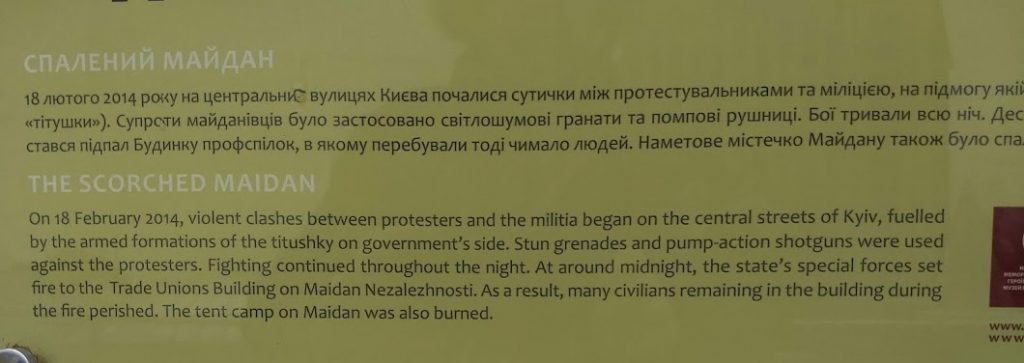
Initially, I am angry at news organizations in the United States for willfully failing the citizenry by neglecting coverage of major events around the world. Even the well-informed in America were largely unaware of the Euromaidan protests happening in this very square over the course of three months during the winter of 2013-14. Why didn’t we know? Why didn’t we hear about tens of thousands of Ukrainians flooding this public space – constructing a tent city; starting an Open University, a grassroots library, a whimsical post office; demanding the resignation of the president; battling against government riot troops known as the Berkut? Why had we in the U.S. ignored this inspiring example of cooperative public opposition? Had there even been a quick moment on CNN’s scrolling ticker announcing 130 deaths in Kiev?
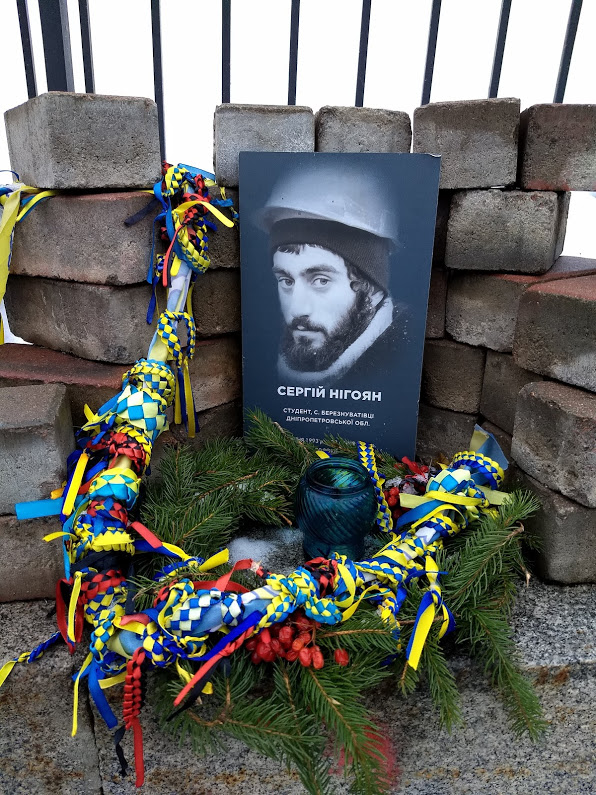
I’m disappointed at my ignorance. How dare I think I have a right to any opinion about my own country when I know so little about the larger context of our shared world?
Moving from placard to placard in the square, I read details about the Maidan protest, learning of President Viktor Yanukovych’s refusal, at the last minute, to sign an agreement with the European Union agreeing to progressive reforms; instead, counter to the hopes and values of millions of Ukrainians, Yanukovych put his pen to a treaty with Russia, in the process accepting a massive loan and aligning his country with Vladimir Putin’s version of nation-building. While many in the eastern part of the country favored Yanukovych’s decision, the overwhelming reaction from the rest of Ukraine was a sustained “NOOOOOOO.” On the evening of November 21st, 2013, the word went out over social media: We are gathering. We are organizing. We have had enough of this government. Together, we will say no.
That night, 2,000 citizens gathered in the square where I stand shivering five years later, setting into motion a revolution that changed the country. Over the course of three months, the number of protesters swelled, and as community infrastructures emerged within the tent city, so did creative liberalizing movements. A piano was brought in. Lectures were given. Music and poetry events were scheduled. Paintings captured moments.
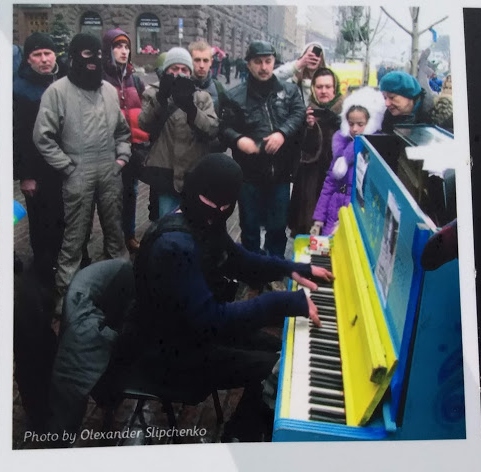
At the same time, the serious business of anarchy was also at work. Molotov cocktails were prepared, eventually hurled. Security forces were formed, their members later becoming part of the Ukrainian Armed Forces when Russia invaded. The guns, tear gas, tractors, tires, chunks of concrete that would allow the protestors to push back against government troops were stockpiled.
As I move around the signs in the square, absorbing the story of the Maidan and trying to stay warm, my respect for the protestors grows with every toe wiggle and thigh slap. The protest grew, and eventually nearly 100,000 fed-up Ukrainians filled this square, claiming the public space as ground to fight for, even during the most brutal months of the year. Their anger, their principles, their passionate insistence that they were through with oligarchies rendered inane talk like “Gee, it’s cold today.” Their sustained, ferocious, life-risking commitment to their cause highlights, in contrast, the Lululemonization of recent U.S. protests in which white women forget not all pussies are pink — although they remember to set down their lattes long enough to snap a photo to post later that afternoon.
Such thoughts are unkind and unfair to American protestors, of course, as all activism is innately performative, and I snort as I accept that I’m an asshole on every continent. But still. Coming from a country that expresses its dissent through #resist and rage-tweeting in response to a rage-tweeter, I am profoundly moved by the Maidan, in awe of how authentic – beautiful, even – the occupation of this square was, extracting sweat, blood, flesh from its participants. The power of the place is upon me. I snuffle as I read firsthand accounts that were shared online after violent clashes erupted in February of 2014, affecting snippets that countered the government’s “official” narrative of bad seeds gone rogue.
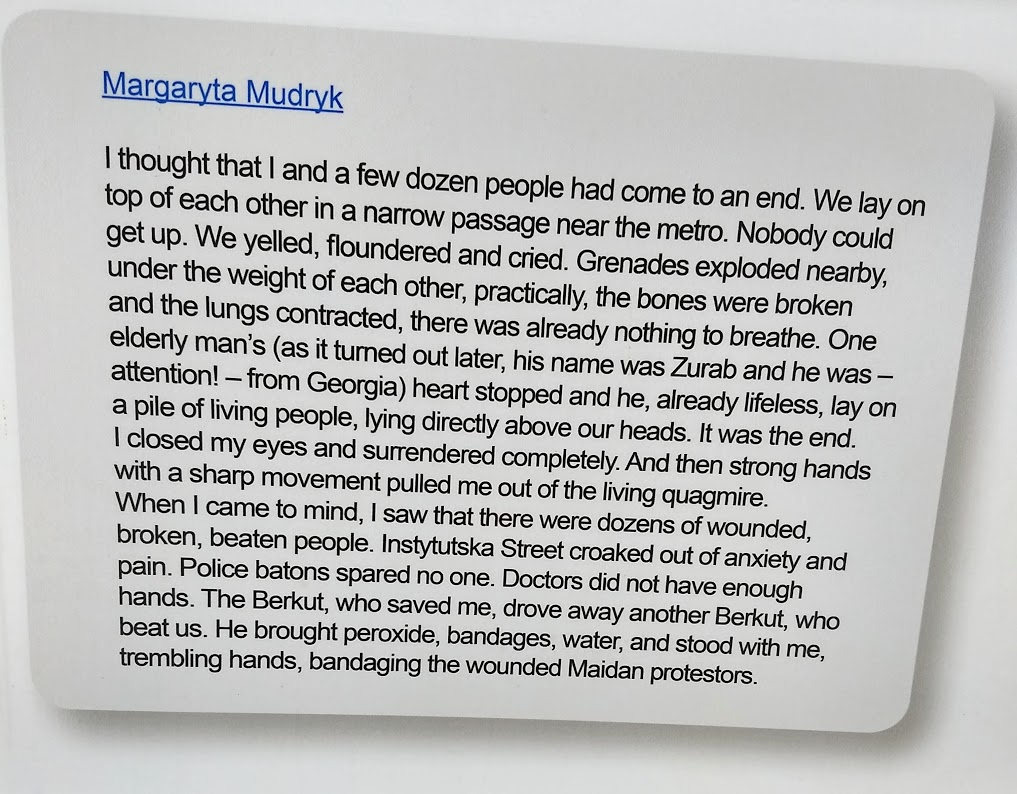
It feels wrong to be standing by myself in this place, the site of powerful collective action. While solo travel gives me the liberty to experience things on my own clock, in my own rhythm, the Maidan makes me wish for a partner, someone with whom to lock eyes in shock and amazement. I know I’m blown away, but I wish my reactions were layered with those of others — that I had someone to exclaim to, a companion in awe.
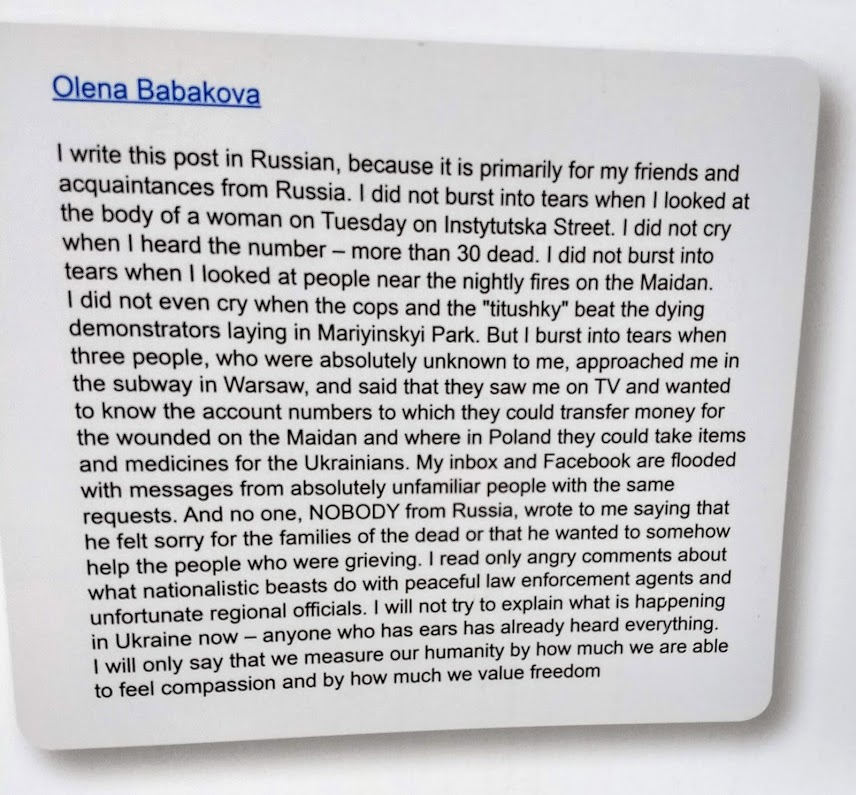
My phone is in my hand; I’ve been taking pictures of the signs, knowing I will
want to review them later. Almost without thinking, I open the family chat that
has accompanied me throughout my months away from home and start typing to my
husband and children – “The people of Ukraine wanted the democracy and benefits
of being European, not a return to authoritarian oligarchy, as seen in Russia.
So they protested. The president bolted to Russia. Official word was that there
had been a lawless coup d’etat. Truth was that the people of a country used
their bodies and power of protest to insist on democracy. It’s all very moving.”
I don’t have international data. These messages will dwell in the limbo of “Unsent. Retry?” until I find wi-fi.
It doesn’t matter. I just need to feel like I’m telling someone about this place.
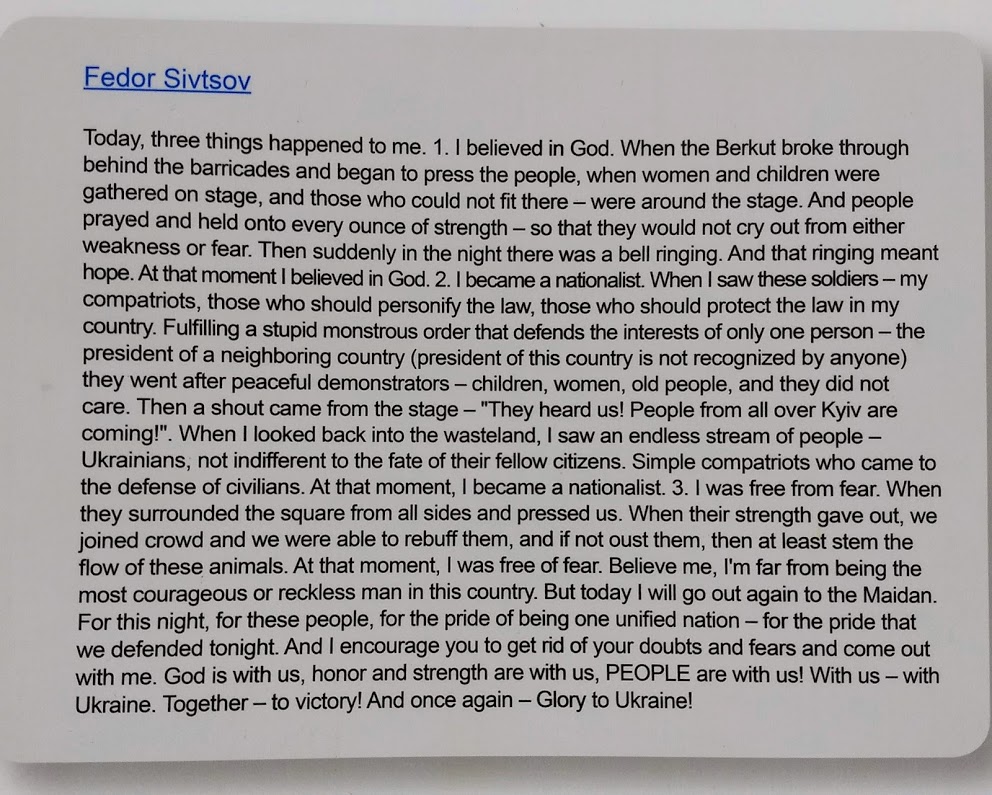
In February of 2014, the Euromaidan occupation of Independence Square reached its peak when government forces killed at least 130 protestors, igniting deeper, more widespread outrage amongst Ukrainians. As clashes intensified and the community established in the square literally went up in flames, the balance of power tipped in favor of the protestors: President Yanukovych was “extricated” from Ukraine with the help of Vladimir Putin and installed into a new life in Moscow; charged with treason and violation of the Ukrainian Constitution, he failed to attend his trial in Kyiv in the fall of 2018 due to knee and spinal injuries sustained while playing tennis.
While Yanukovych has been honing his backhand, Putin has been asserting Russia’s desire to keep a grip on Ukraine. On the heels of Yanukovych fleeing, tanks rolled into the Crimean region of Ukraine and annexed it as part of Russia. At the same time, Russia began pushing conflict in the Donbass region of Ukraine, a war which, according to the Brookings Institution, has claimed more than 10,000 lives in the past five years.
As my brain processes what I’m reading, I step gingerly across icy patches, trying not to wrench an ankle as I mull over the profound and continuing costs of the Maidan protestors achieving their goals. The Russian-leaning president was ousted. A reform-minded president was appointed by parliament. The people had risen up, banded together, and given their lives for their nation.
Standing in front of the last sign, rubbing the tip of my nose to restore sensation, I am possessed by emotion, by a single blunt reaction to all I have just learned: what those angry Ukrainians did in the bitterly cold months of 2013-14 was so badass it’s threatening to make me believe in something.

I will learn later from articles online that the impact of the Maidan went beyond ousting a corrupt president and rousing patriotism. For those who participated in the protests, the tip from passivity into action has had lasting consequences. One protestor, a woman who cooked for the demonstrators, Halyna Trofanyuk, reported to The Guardian that she was changed by the three months she spent living in the square.
“I used to be timid,” she says. “But you’d better not mess with me now. If necessary, I can get people behind me and convince them that you have to fight for what you need and not wait to see what others give you.”
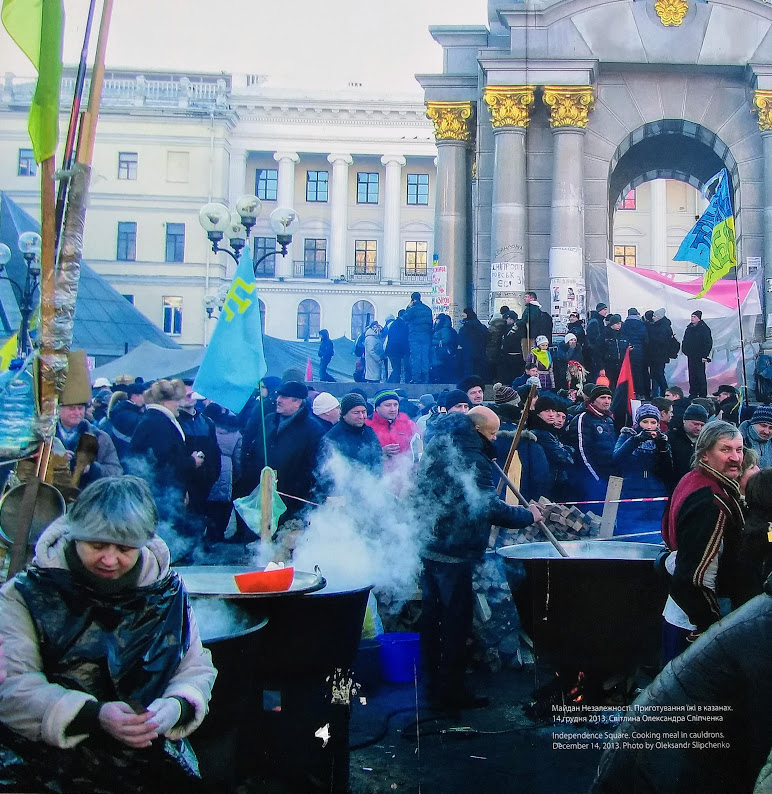
People like Trofanyuk, people like the 130 who were killed by government troops, people like the man in a black ski mask who sat at an upright piano and banged out an incongruous song, people like the thousands of Ukrainians who heard something was going down in Independence Square – shit was getting real – and instead of watching to see what happened put on their hats and coats and added their bodies to the number –
Those people were so badass it’s threatening to make me believe in something.
But it’s cold. My teeth are clacking. It’s the first day of 2019, not 2014. There’s a heated shopping center below my numb feet, a bright, shiny place full of coffee shops and bathrooms.
So.
I pull out my phone, readying it to connect to wi-fi and send those messages. I walk through the sliding glass doors of the brand-new mall. And I turn my back on the frigid power of Independence Square to step into the familiar warmth of capitalism and public isolation from others.
Upstairs near a jewelry shop with hundreds of diamond rings glinting from their perches on black velvet, I sit on a tall stool, stir a packet of sugar into my too-hot cappuccino, and consider
fury,
violence,
sacrifice,
revolution and riots as agents of change.
Gnawing on my stir stick, I consider all the many things the Maidan might make me believe in.
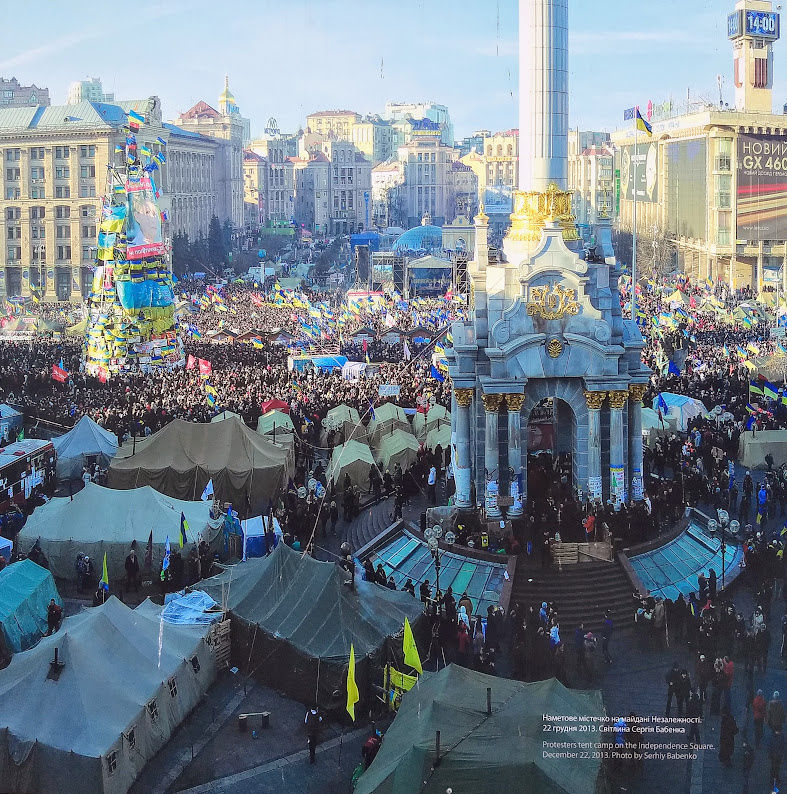
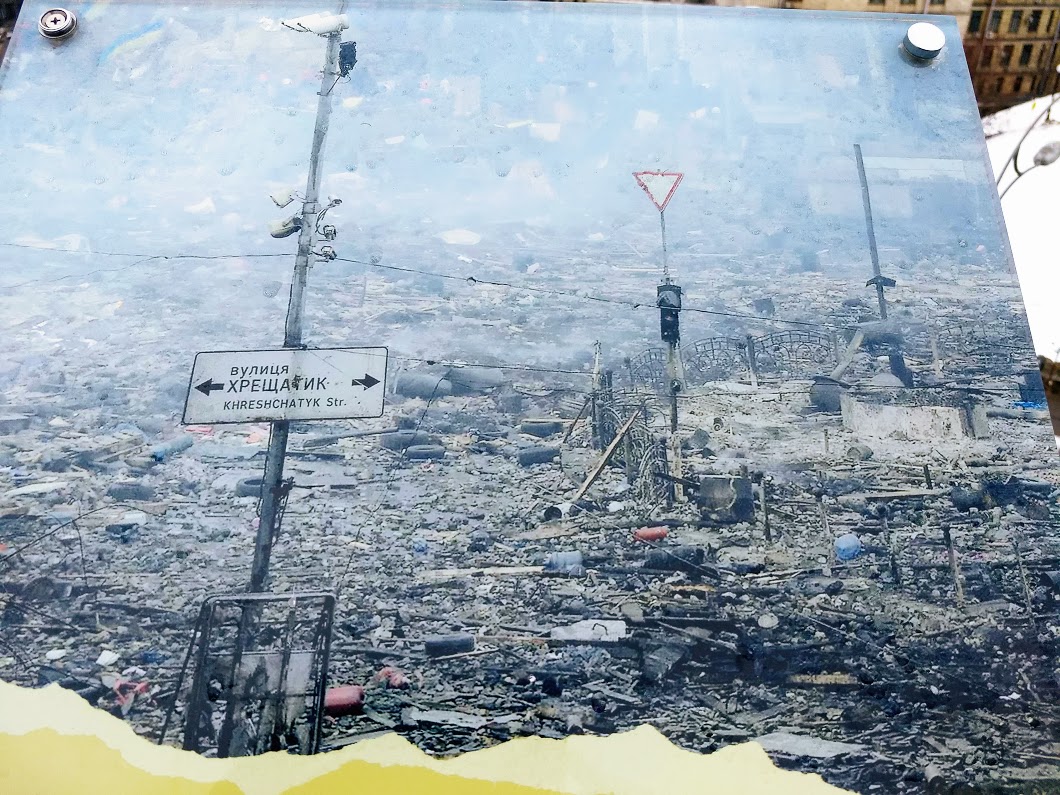

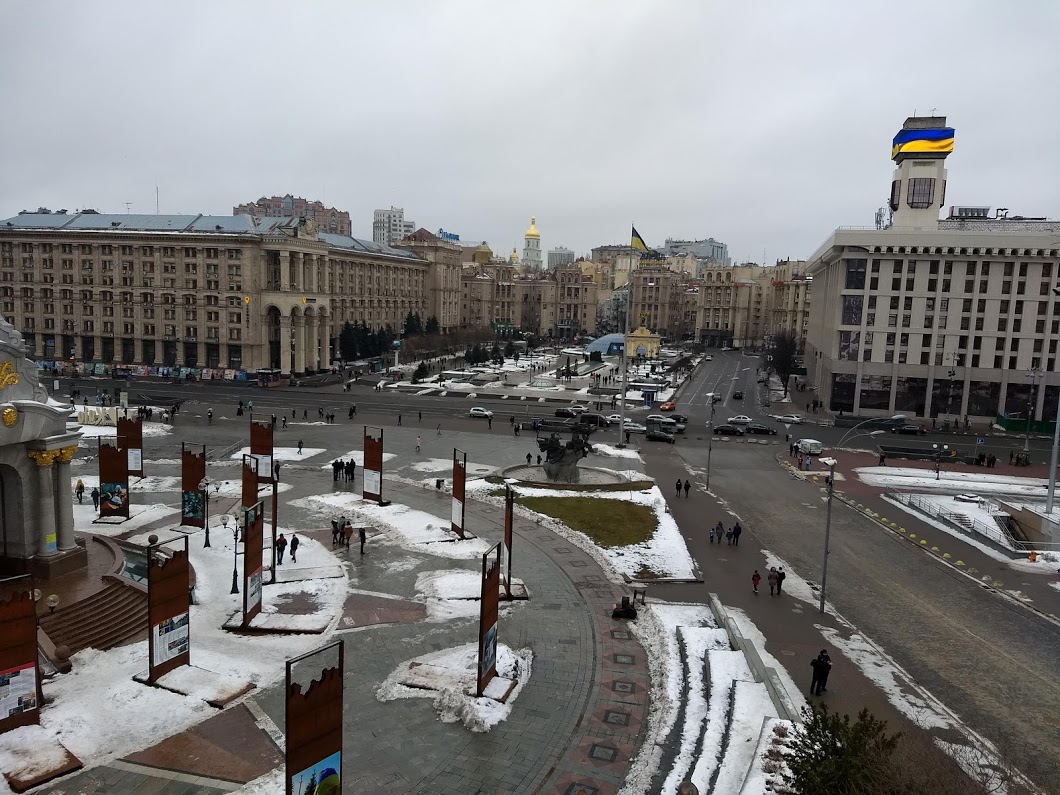
Leave a Reply